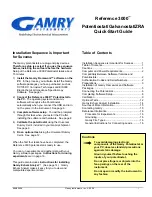
13
3.4 Internal Adjustment of the Sensors
General information
:
If the sensor has been delivered with a display unit, the ZERO and GAIN adjustments
should only be carried out with the supplied display unit.
All tension meters are calibrated with standard materials - such as polyamide monofila-
ment (PA) - according to the SCHMIDT factory procedure; the material path is vertical.
Any difference in process material size and rigidity from the standard material may cause
a deviation of the accuracy.
In 95% of all industrial applications the SCHMIDT calibration has been proven to provide
the best results and is used for comparative purposes.
If required you can also operate the sensors with a material path other than vertical.
Should the process material differ significantly from the SCHMIDT calibration material
in size, rigidity or shape, we recommend special calibration using customer supplied
material. If the material path is other than vertical or if the process material deviates sig-
nificantly from the SCHMIDT calibration material, you need to carry out static
ZERO
and
GAIN adjustment
as described in Chapters 3.4.1 and 3.4.2.
3.4.1 ZERO Adjustment
Mounting holes 4x
Weight
fig. 3.4a
fig. 3.4b
Material path
symbol
Measuring
roller
Guide rollers 2x
ZERO
GAIN
fig. 3.4c
- Install the sensor in the desired position at the measuring location using the provided
mounting holes.
- Allow approx. 10 minutes for thermal stabilization of the sensor.
- Thread the process material through the measuring and guide rollers, following the
material path symbol on the front of the sensor.
When threading the process material through the rollers, follow the material
path symbol on the front of the sensor. If a force is applied to the middle
sensor roller in the incorrect direction, damage could result.
Since ZERO and GAIN adjustments are always performed statically, the readings
may differ under dynamic load.










































